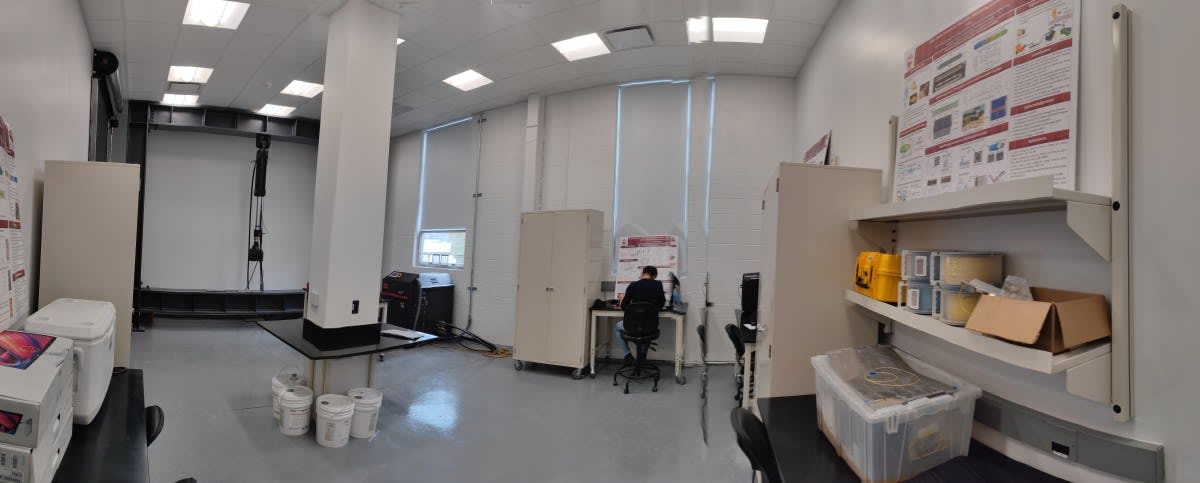Renovated Smart Infrastructure Lab Propels Innovative Civic Research
New lab allows CEOE students and faculty develop super concrete and conduct large-scale tests
Stevens’ new Smart Infrastructure Laboratory places students and professors at the forefront of civic innovation, at a time when the U.S. is on the brink of an infrastructure revolution. Assistant professors Yi Bao and Weina Meng, who lead materials and infrastructure research in the Department of Civil, Environmental, and Ocean Engineering (CEOE), have completed a years-long initiative to renovate their labs and expand their department’s research and testing capabilities.
“In order to improve civil infrastructure, our Smart Infrastructure Lab develops new materials, sensing technologies, structural designs, and automatic methods for constructing and operating future civil infrastructure,” said Bao. “Aging infrastructure is one of the grand challenges of this century, and our research in the Smart Infrastructure Lab is devoted to addressing those challenges.”
These research projects range from developing advanced materials to creating innovative structural engineering strategies, all while integrating machine learning algorithms and sensing technologies.
Yi Bao, the head of the lab, works closely with his next-door colleague Weina Meng, who researches and develops construction materials as the head of the Advanced Concrete Technology (ACT) Lab. The magic of smart infrastructure emerges when these two labs and minds combine. Meng, along with her research assistants and undergraduate students, create ultra-high-performance concrete in the ACT Lab and then bring it to Bao and his students who begin to build with and test it in the Smart Infrastructure Lab. “This is another beauty of the lab,” said Bao. “Students could mix concrete in one room, fabricate the specimens, then move them next door for large-scale structural testing.”
Thanks to its recent renovations, the Smart Infrastructure Lab will expand the reach and scale of the CEOE department’s infrastructure research and make the entire process more efficient. Set within a 500-square-foot area, the lab has all sorts of tools and equipment to build with and stress test advanced materials. The main feature of the lab is a load frame equipped with a hydraulic actuator, used for mounting, maneuvering, and testing built structures. There are two environmental chambers that simulate harsh environments in which materials are exposed to the extremes of temperature and moisture. Additionally, the lab has equipment to measure other properties of the materials, such as how porous they are and how they respond to heat, light, and impact.
Collaborate, innovate, renew
In these labs, opportunities abound for students to get hands-on experience, where classes of 40 to 50 undergraduates can mix, cast, and test super concrete and experiment with LEGO®-inspired building methods. Outside of civil engineering courses, students can get involved through summer research, joining Bao, Meng and Ph.D. students, and contribute to their publications. “They get excellent training in technical paper writing, and eventually, we acknowledge all of them in different papers,” said Meng.
With a set of ambitious research questions to explore and equipped with the new capabilities of the Smart Infrastructure Lab, Bao, Meng and CEOE students are poised to lead the infrastructure revolution. “This is the time to renew the old infrastructure of the U.S.,” said Meng. “This lab is exciting for us, as we may do some work to really help refresh our infrastructure here.” The ultra-high-performance concrete material is already being implemented on a bridge repair project with the New Jersey Department of Transportation, and there are surely more projects to come.
Along with the leap to advanced materials, Bao anticipates a time in the near future where civil infrastructure integrates modern machine learning technology. “These smart functions will help improve the mechanical performance, sustainability, and resilience of structures. We are incorporating different types of sensing and visualization technologies to identify damages and improve safety,” he said. Now that the renovations of the Smart Infrastructure Lab are complete, Bao and Meng are eager to ramp up their research by taking advantage of the lab’s new testing capabilities.
Learn more about civil, environmental, and ocean engineering at Stevens:






